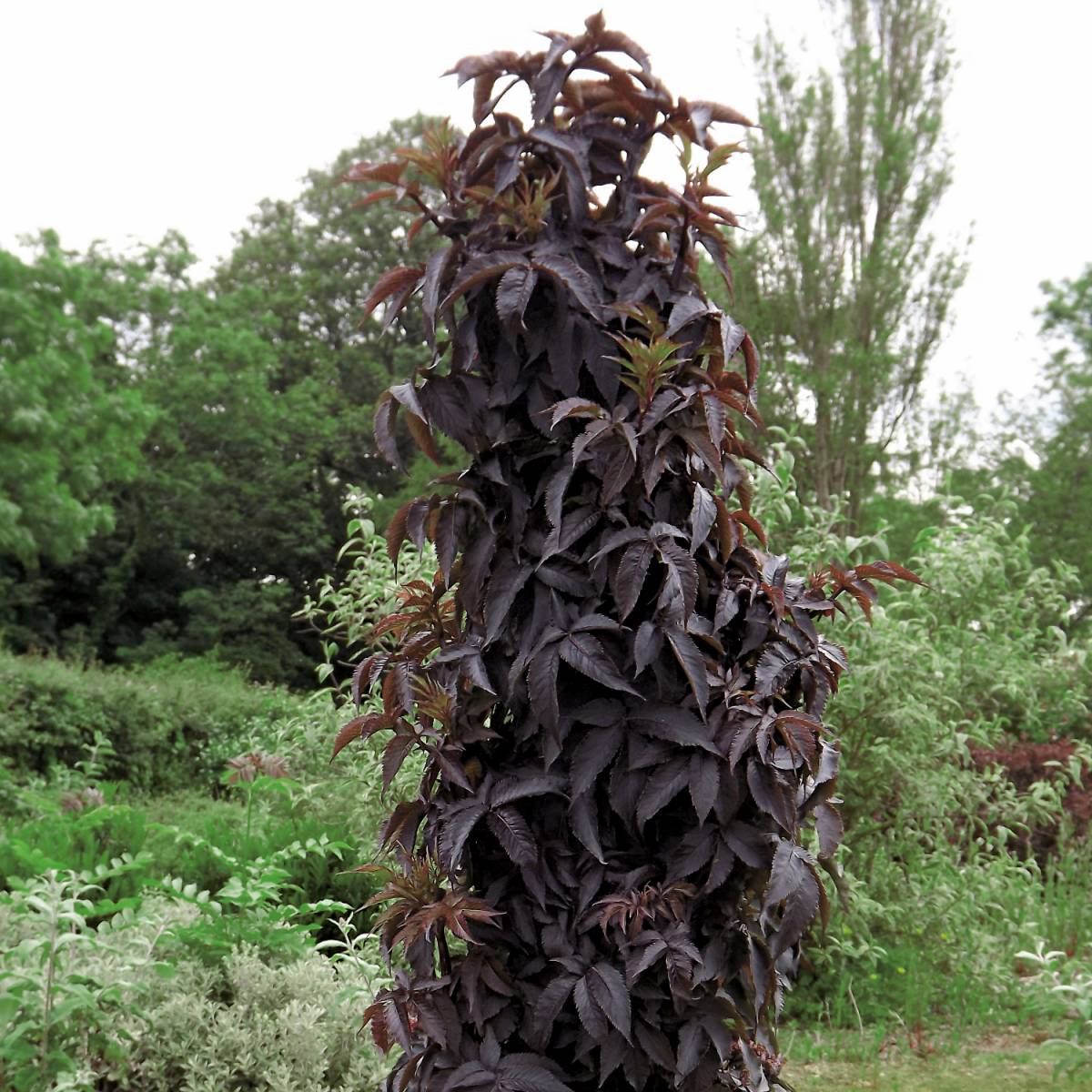
7 columnar shrubs
Our tips to draw attention to your flower beds with upright shrubs!
Contents
Points d’exclamation du jardin, le narrow shrubs, with their upright silhouette, bring rhythm, mark, and structure the flower beds. Whether their foliage is evergreen or deciduous, whether they are small or larger in size, they highlight the rounded or loose plants throughout the seasons. If you want to plant them in the garden and are scratching your head trying to find which plants to use to bring this verticality to your flower beds, look no further! Here is a selection of 7 columnar shrubs and conifers, essential in our collection.
Chinese Viburnum ‘Kilimanjaro’
These magnificent Viburnums, multiple award winners, naturally adopt a narrow and pyramidal habit that is very decorative. Viburnum plicatum ‘Kilimandjaro’ is adorned with stunning pure white flowers from May to June. They take the form of flattened corymbs and are followed by small red berries at the end of summer. As they ripen and turn black, the plant becomes a pantry for birds! The foliage is deciduous and turns purple before winter. The variety ‘Kilimanjaro Sunrise’ shares the same characteristics, but its spring flowers are tinged with soft pink. Both grow to just over 1.6m tall with a spread of 1m. Therefore, it will be easy to find a place for them, even in small spaces. Hardy down to -15°C, these Chinese Viburnums prefer moist soil and either full sun or light shade, conditions that provide an excellent environment for some spectacular foliage, particularly for hellebore, such as Helleborus orientalis ‘Double Blanc’ with its beautiful pure white flowers. The ample dark green, cut foliage of ornamental rhubarb Rheum palmatum ‘Tanguticum’ will happily complement the upright silhouette of the Chinese Viburnums, with a carpet of Myosotis sylvatica ‘Savoie Blue’ and Hosta plantaginea ‘Aphrodite’, delicately scented, in the foreground.

From left to right and top to bottom: Viburnum plicatum ‘Kilimandjaro’ and a detail of the flowering of the variety ‘Kilimanjaro Sunrise’, both in bloom in May-June, followed by Helleborus orientalis ‘Double Blanc’ which flowers from February to April, Rheum palmatum ‘Tanguticum’, Myosotis sylvatica ‘Savoie Blue’ in bloom from January to June, and Hosta plantaginea ‘Aphrodite’ which will take over in August-September.
Read also
Trees and bushes: different habitsAcer palmatum 'Twombly's Red Sentinel'
Cultivated in Japan for centuries, the main asset of palmate maples is their elegantly lobed foliage. With Acer palmatum ‘Twombly’s Red Sentinel’, it varies from purple to fiery red depending on the seasons. Another characteristic is its narrow, upright habit, hence the name “red sentinel.” It is not particularly fragile but requires somewhat specific growing conditions: it prefers rich, cool, rather neutral soils and is sensitive to atmospheric dryness. Drafts should be avoided, so it needs a well-sheltered spot to prevent its leaves from drying out. Its growth is rather slow, reaching a height of about 3m at ripeness. For a dazzling autumn and winter display, pair it with Hamamelis and Parrotia persica.

Acer palmatum ‘Twombly’s Red Sentinel’, Hamamelis and Parrotia persica
Discover other Upright trees
View all →Available in 0 sizes
Available in 1 sizes
Available in 1 sizes
Available in 1 sizes
Available in 1 sizes
Available in 1 sizes
Available in 1 sizes
Available in 1 sizes
Available in 2 sizes
Available in 1 sizes
Japanese Styrax ‘June Snow’
The Styrax japonicus ‘June Snow’ is a beautiful shrub, also native to Asia, whose branches are covered with snow-white flowers in June, hence the name of the variety: ‘June Snow’. Like other Styrax, it is deciduous and prefers rich, cool, slightly acidic soils and a position in partial shade. Being sensitive to spring frosts that damage flower buds and young shoots, it will find its ideal place in a sheltered position. This variety is very decorative and elegant with its slender silhouette that will stretch to about 4m with a spread of 1m. It will wonderfully punctuate a fresh woodland border, associated with Loropetalum chinense ‘Pipa’s Red’ and Hydrangea aspera ‘Macrophylla’.
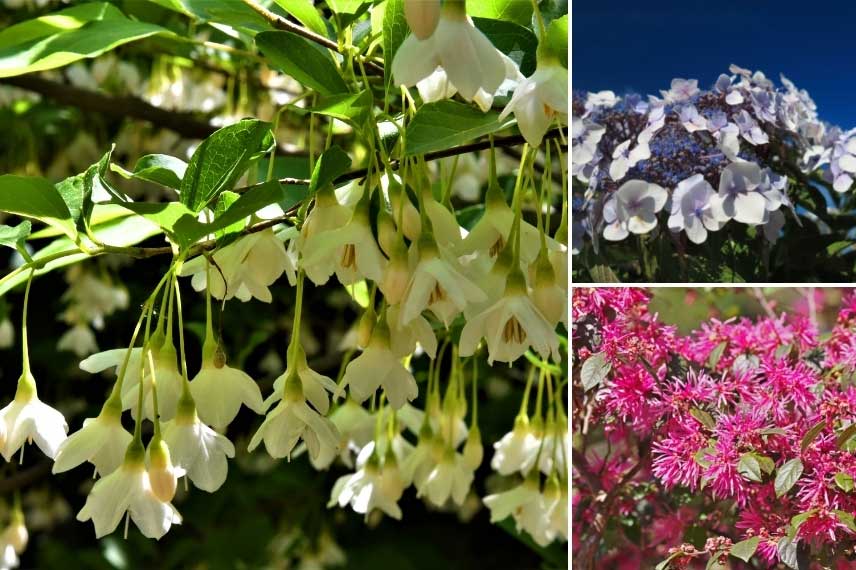
In June, the flowering of the Styrax japonicus ‘June Snow’, followed by that of Hydrangea aspera ‘Macrophylla’ in summer and that of Loropetalum chinense ‘Pipa’s Red’ repeating at different times of the year depending on the climate
Sambucus nigra 'Black Tower'
To create a warm-toned border, Sambucus nigra ‘Black Tower’ will work wonders! Positioned at the back and dominating the scene with its tall, slender form, its dark purple deciduous foliage and pink flowering in May-June will highlight Monarda ‘Cambridge Scarlet’ and Helenium ‘Windley’, both in bloom from July to September, as well as Ligularia stenocephala ‘The Rocket’, which will flower from March to April and then again in September-October. It grows to about 2.5m, tolerates all types of soil, and its planting in the garden will guarantee success even for beginner gardeners!
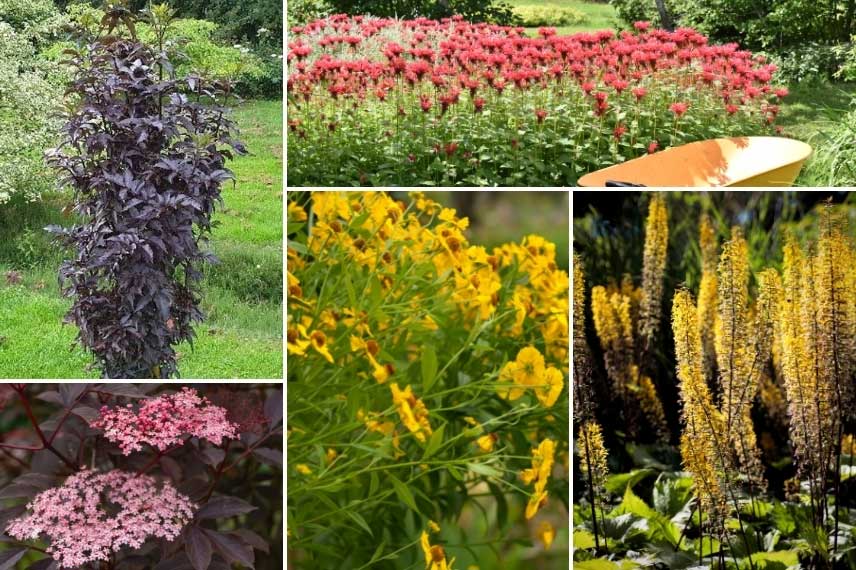
Sambucus nigra ‘Black Tower’ shrub and detail of flowers on the left, Monarda ‘Cambridge Scarlet’ at the top, Helenium ‘Windley’ in the centre bottom, and Ligularia stenocephala ‘The Rocket’ at the bottom right
Japanese spindle and crenate holly: 2 evergreen columnar shrubs to replace boxwood
The common name for spindle comes from the Latin “fusago,” which means spindle, as the wood of this shrub was used in ancient times to make these spinning tools. The genus comprises over 120 species, and the Euonymus japonicus originates from Asia. The one we are interested in here is Euonymus japonicus ‘Benkomasaki’ – a Japanese cultivar – with a compact and very erect habit of 1 to 1.5 m in height. Its foliage is evergreen, with a beautiful glossy green. It has the advantage of thriving in almost any condition: in sun or shade, in all soils preferably well-drained, exposed to sea spray or urban pollution. The crenate holly Ilex crenata ‘Fastigiata’ adopts the same erect silhouette and can reach a height of 2.5 m. It can be easily managed through pruning to form hedges, borders, and topiary subjects. It is very hardy but will prefer a deep, cool, well-drained soil and should be protected from full sun. Both can find their place in pots on the terrace for a hassle-free green presence, but they are also interesting alternatives to replace boxwood devastated by box tree moth, as they lend themselves admirably to pruning and topiary art.
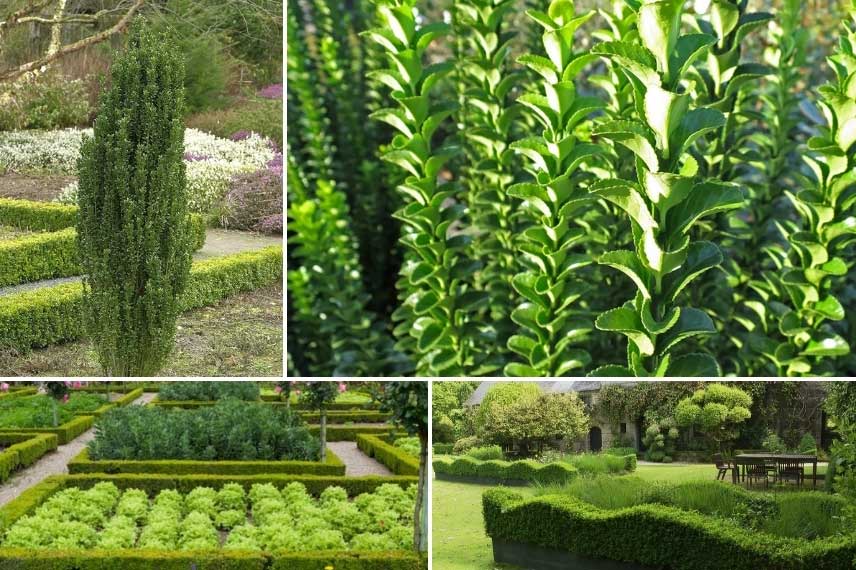
Ilex crenata ‘Fastigiata’ and Euonymus japonicus ‘Benkomasaki’, advantageous alternatives to boxwood
The fastigiate yew
Two varieties of yews are particularly fastigiate and elegant: Taxus baccata ‘Ivory Tower’ and Taxus baccata ‘Fastigiata Robusta’. The former is a variegated columnar yew, while the latter is a fastigiate common yew. With dense foliage that responds well to pruning, these conifers are ideal subjects for topiary. Taxus baccata ‘Ivory Tower’ is a variegated variety with very bright cream-tinted foliage. Its slender silhouette, reaching up to 3 metres, can stand guard in the corners of a small classic square or rectangular garden, emerging from carpets of Alchemilla mollis, punctuated by Leucanthemum ‘Victorian Secret’ and Lupin ‘Gallery Yellow’.
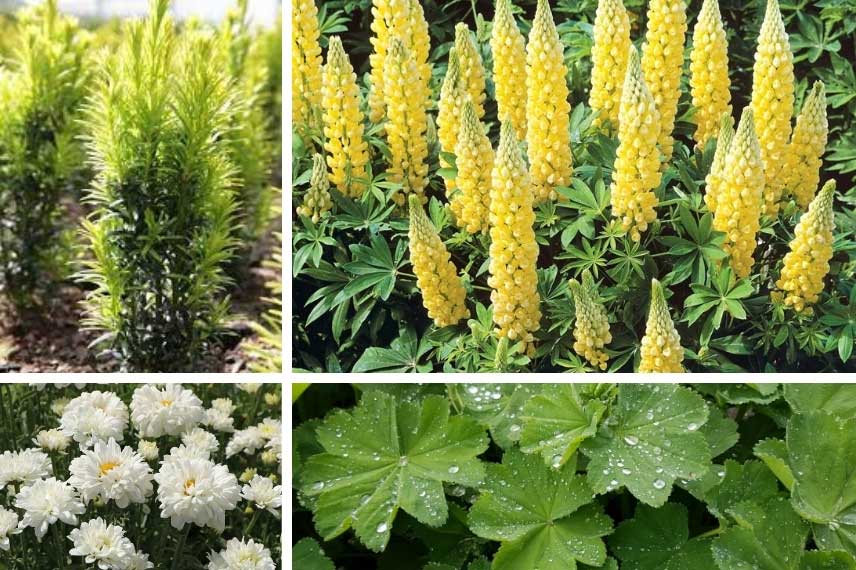
Taxus baccata ‘Ivory Tower’, Lupin ‘Gallery Yellow’, Leucanthemum ‘Victorian Secret’ and Alchemilla mollis
Taxus baccata ‘Fastigiata Robusta’, with deep green foliage, will complement the upright spikes of Kniphofia ‘Wrexham Buttercup’ and Acanthus mollis ‘Latifolius’, set against a backdrop of Ligustrum ibota ‘Musli’.
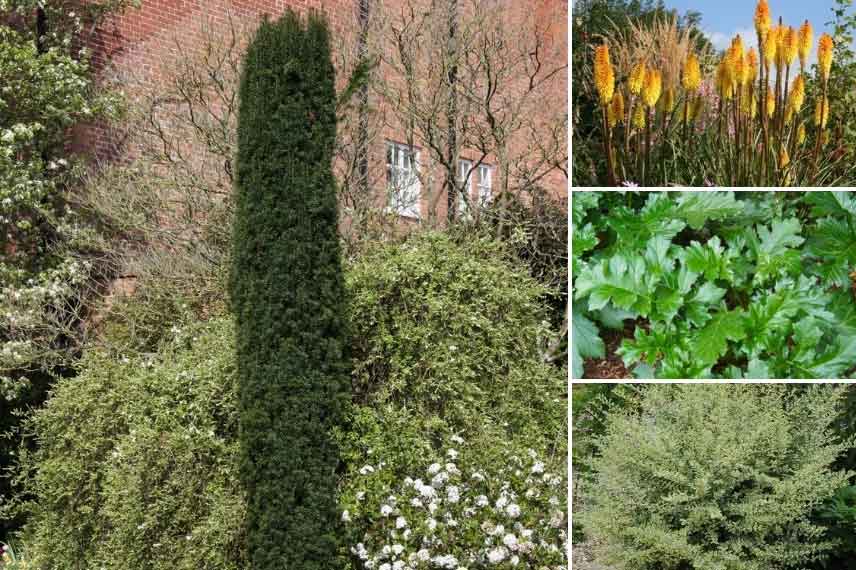
Taxus baccata ‘Fastigiata Robusta’, Kniphofia ‘Wrexham Buttercup’, Acanthus mollis ‘Latifolius’ and Ligustrum ibota ‘Musli’
- Subscribe!
- Contents
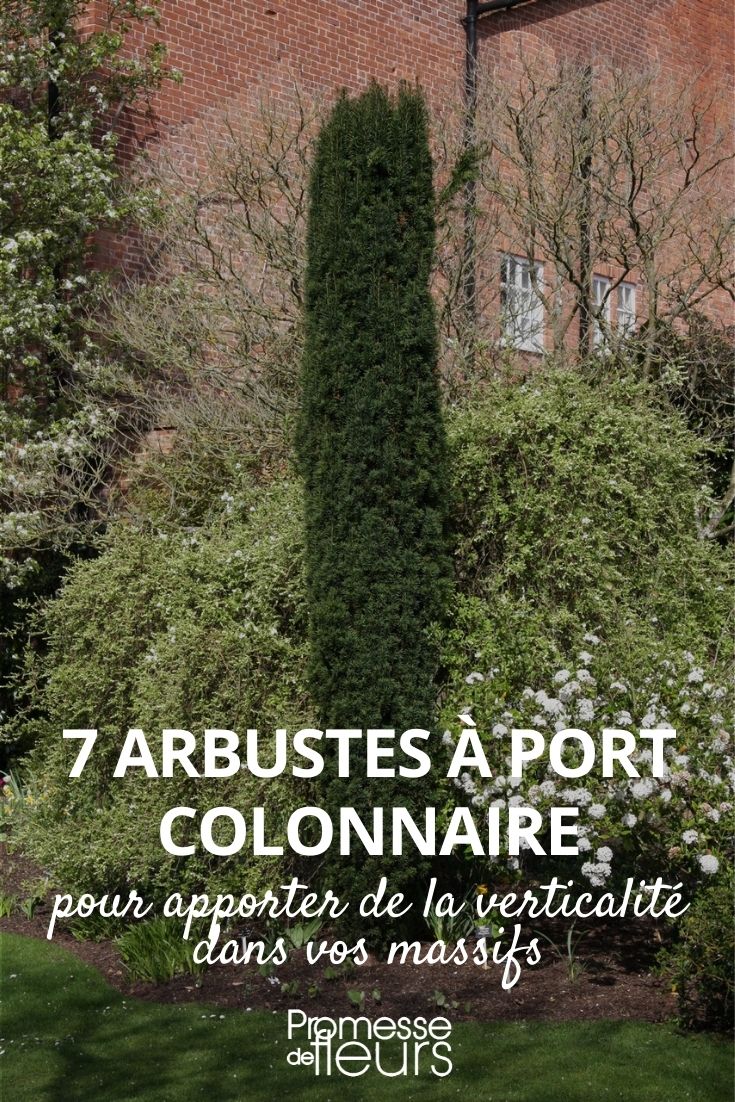
































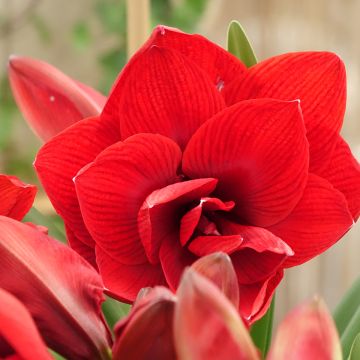




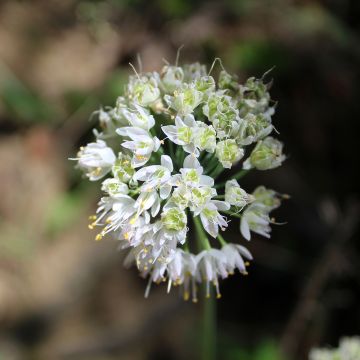
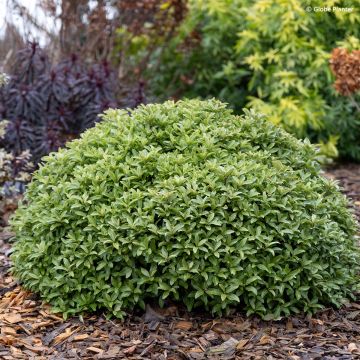
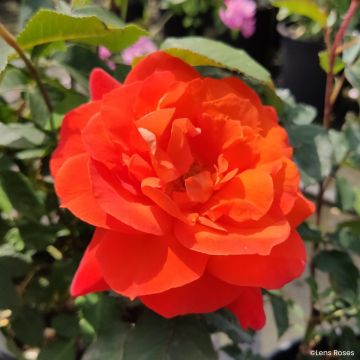

Comments